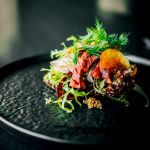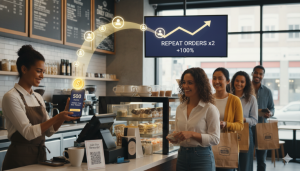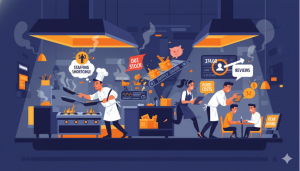Restaurant menu management is like art; everyone doesn’t get it right the first few times.
A “wrong” menu raises red flags among customers. It can drive people away instead of attracting them. Meanwhile, you will keep scratching your noggin’, only to realize later that it was the menu that needed work, and not your perfect service standards, efficient staff, and vice versa.
According to the experts at the ‘National Restaurant Association’s Industry’, a recent report highlighted that food item prices have increased by at least 25% over the last few years. In addition to the high ticket price of the food, restaurants have to deal with the looming reality of playing around with expiry dates for all their items in the storage unit.
Sooner or later, food items begin to get stale. Either, these items have to be used quickly, or they need to be discarded before they become a source of health hazard and bad reviews for the food business operators just like you?
The question is, where does restaurant menu management come in? For argument’s sake, (*and this is a very common scenario), you have stocked up on your food items inventory at a certain price. However, unknowingly, your restaurant menu management skills are lacking, which eventually results in no sales, or slow days for months on end.
Soon enough, pressure will start building up. You will have to get rid of stale food and replace it with newer/fresher ingredients that won’t last forever either if the menu isn’t optimized at the front end. Now, do you see the picture?
The bottom line is: there’s a hole in your boat. It’s sinking fast unless and until you put a cork in there for immediate damage control.
From the looks of it, since you need to work on things from the perspective of restaurant menu management to drive more sales, and attract new customers, this “cork” needs to be mighty big before it’s too late!
Understanding The Science Behind ‘Restaurant Menu Management’:

Let’s start with a simple logic behind profits.
Profits for any business, whether it is food-related or not, are a result of the following factors:
- No. of Sales – How many food items or online food orders you fulfill?
- Labor Cost – The payroll that has to be divided among employees
- Overhead Expenses – Utility bills, maintenance bills for your restaurant, etc.
In terms of restaurant menu management skills, the above information translates to the following equation.
Profit = Labor Cost – No. of Total Sales – Overhead Expenses
Deduce all three from the total revenue generated. The leftover amount is your profit. Period.
For F&B business owners, there are different strategies to drive more profit towards the end of a fiscal year. There’s social media management, marketing goals, advertisements, time-gated deals, and the way your play around with the cost of the sales factor. The list could go on.
For the sake of this write, we’ll focus on the baseline factor that directly impacts your ability to make sales. And, that my friends, is your plain and simple restaurant menu. If the dishes are too damn tasty, and they are adjusted within different slots to maintain feasibility in a way that you don’t end up selling at a loss, the business can scale at an exponential level.

Fig. 1: Restaurant Menu Matrix
The above diagram is what food menu experts like to call: a menu matrix. It’s easily available on the internet because of its vital importance during the restaurant menu management process.
There are plenty of hospitality business online platforms that offer a mini degree course on the art of restaurant menu engineering. You can sign up for these courses to understand the importance of engineering a powerful restaurant menu that can help to increase profit, without compromising on customer quantity.
So, when we talk about the science of restaurant menu management, we need to look at it from a menu engineering perspective.
Just to backtrack a little bit, it’s important for you to price your food order menu for maximum profitability in the beginning. This needs to be done correctly to resonate with your customers’ behavior.
If they like X number of food menu specialties, you can increase the respective price without fussing too much.
[INSERT_ELEMENTOR id=”2061″]
Secondly, you need to understand your way to restaurant menu management according to the matrix diagram above. It interprets roughly into the following quadrants:
- Horses: Also known as PlowHorses, they are your high popularity items that don’t net a huge amount of profit.
One such example of PlowHorses are your rare special dishes, such as the fresh catch of the day, served with a side of delicious, but low cost, sauces made from cheap ingredients. If such items become popular, you can increase their price to impact your profit level.
- Dog(s): This one is the usual low popularity item that also isn’t very high on generating profit.
Think of ‘Dog’ restaurant menu management items as kids’ burgers and family dishes that are an important part of the entire menu. These items are not that high in demand, but you can upsell on them by having the waiter mention ‘Dogs’ while he’s reciting a list of all the dishes.

Typically, these menu items are mentioned on the last page, or on the backside of the menu because they are not super important!
- Star: The delightful assortment of your most popular dishes with a high profit and high popularity index all over!
Bank on your ‘Star’ food order menu items like crazy. If your customers love them, you can fiddle around with price brackets through discount deals, time-gated promo offers for online restaurant food orders, and vice versa.
These items are supposed to be showcased top-fold, in case of a mobile food ordering website or application. For regular paper-based menus, the Star restaurant menu management category goes to the top section of the front page or the top section of each page for maximum attention.
- Puzzles: Don’t we love them all? These are mystery dishes on your food order menu that are hard to sell despite the high-profit index.
Feel free to tweak the recipes for the ‘Puzzle’ category restaurant menu management items. You can also upsell ‘Puzzle’ items to your regular customers by mentioning that the chef created something special that is only for valued regular customers.
Build upon the ‘appeal’ and ‘curiosity’ factor to entice your customers. If they perceive it as a rare delicacy, they might pay a little extra to have a bite of something that you’d been trying to sell for quite some time now.
Control F&B Cost for Optimized Restaurant Menu Management:

The cost of food is incurred at two levels – i.e., your actual purchase cost of the ingredients for that food item and the expense incurred in preparing your dish.
Likewise, when we talk about beverage cost, it’s the result of your purchase price and the cost incurred during beverage preparation. The latter applies to cocktail drinks and special acholic/non-alcoholic recipes that your designated staff member is an expert at preparing.
Having said that, for an optimized restaurant menu management effect, you need to control the cost of food and beverage items. You can do so in a number of different ways.
For instance, you can buy cheap ingredients that aren’t highly expensive as their counterparts. If it’s a pizza you’re preparing, buy cheap mushrooms instead of going for exotic rare mushroom types. Your customers won’t notice a huge difference, until and unless you specifically mention the type of mushroom you use on your pizza, or if it is requested by the customer otherwise.
Similarly, beverage control cost can be done in a number of ways.
Let’s say, you are selling vintage wine. Its cost can be controlled by upselling based on ‘Per Glass’ vs. ‘Entire Bottle’ policy. Vintage wines are expensive, which also means that restaurants can make an extra buck if it’s sold by the glass, instead of an entire bottle.
Standardize your Food and Drink Portions:
Standardization is another important aspect of restaurant menu management, where many business startups fail to realize its efficacy.
Each menu item has to be portion-controlled, weighed, and prepared to reduce waste. If someone has ordered a side of mashed potato on a special spaghetti dish, that’s great! However, think of all the potatoes that will go to waste if you end up creating an extra serving that will go stale if it isn’t ordered soon.
Portion control for fresh meals is important because a lot of items cannot be stored in the refrigerator for long. Over the course of 2 – 3 days, these dishes lose their taste, and they also get a tinge of other items that are placed within the same storage unit.
Train your staff to use portion control techniques through measuring scales, cups, and jiggers. Avoid overpouring and overpreparing because there is never a guarantee whether your next customer will order the same thing or not.
Digital Menu Optimization and Promotion:

Online restaurants rely on digital menus since everything has to be pushed to the frontend through a visually optimized interface that’s easy to navigate through. This effect is called digital food menu optimization, or user experience, in other words.
Unfortunately, for name-brand food businesses, there is a very small wiggle room to make errors on their digital menu. Important deals that aren’t mentioned on the mobile food ordering app’s strapline will be missed by customers as they won’t be able to see them.
Likewise, when you are in control of creating your restaurant digital menu, make sure that the service vendor who’s offering menu creation options, understands your requirements. Menus are supposed to be made quickly without wasting too much time. If these menus are complex for customers, difficult to create, and unresponsive, you may end up losing revenue without possibly identifying the reason behind it.
Blink Co. offers a robust menu creation system, alongside many powerful tools to online restaurants. Our responsive UI, white-labeled back n’ front end, and marketing tools serve as a safe haven for food business startups looking to ace their restaurant menu management skills like a pro!
The best part about Blink’s services is the monthly subscription fee. The company doesn’t charge a flat percentage by the order but offers you different subscription plans instead. These plans are easy to manage and don’t dent your revenue + profit generation schemes from long term business partnership perspective.
Check out more details at Blink for Restaurants webpage today.
Restaurant Menu Forecasting for Hot Selling Items:
For ‘X’ number of popular dishes, there are certain customers that order it on a loop.
It roughly translates to your restaurant menu management ability for preparing sizeable chunks of food for all-time bestsellers on the menu. Forecasting the menu by understanding demand and supply helps to reduce the risk of over-purchasing and out-of-stock scenarios.
Since some of your dishes are going to be awfully popular, you’ll know that you can purchase the raw materials required to prepare the menu without wasting time, effort, and money. Likewise, you can also gamble on preparing certain items of the dish in raw form, so that it can be prepared to full state as soon as another order comes in.
This entire phenomenon is called restaurant menu forecasting. Eventually, it will bolster your sales without affecting the profitability or negative revenue.
The best way to forecast your menu is by analyzing the sales trend. Point of Sales software predicts the footfall trend through reports. These programs give detailed insight on the most popular menu items vs. the maximum number of sales made over the ‘XYZ” time period.
Analyze the trend, and you will have an upper hand over how professional-level restaurant menu management is practiced in dated establishments.
[INSERT_ELEMENTOR id=”2061″]
Have You Tried Restaurant Menu Management Before?
If so, we’d love to know the extent of your restaurant menu management strategies in the comments section below.
We rely on the knowledge shared by our patrons to empower small businesses in the F&B industry. After all, your best friend is someone who gives you low expectations with enough knowledge that results in an informed decision-making process.
Go ahead, and give us a holler below. We look forward to hearing from you!
Related Articles:
 Explore 31 Unique Food Business Ideas for 2023: Profitable Ventures
Explore 31 Unique Food Business Ideas for 2023: Profitable Ventures
 8 Innovative Restaurant Menu Ideas to Prevail Beyond 2021 (A Post COVID Brief)
8 Innovative Restaurant Menu Ideas to Prevail Beyond 2021 (A Post COVID Brief)
 Before You Scale, Define your Restaurant Marketing Objectives
Before You Scale, Define your Restaurant Marketing Objectives
 Top 5 Ideas for Restaurant Marketing in 2021
Top 5 Ideas for Restaurant Marketing in 2021
 2023 Restaurant Owners’ Guide On How to Get a Michelin Star
2023 Restaurant Owners’ Guide On How to Get a Michelin Star




